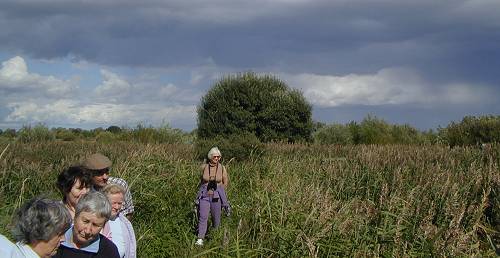
Back to the Index page
[Bird list below]
Some 17 members and guests came on this trip to Wheldrake Ings, led by our bird specialist Jim Pewtress. We enjoyed good weather with clear air, plenty of sunshine and some very photogenic cumulus clouds (rather blacker and more threatening-looking over and downwind of the big power stations near Selby).
Wheldrake Ings is an important nature reserve, consisting of the river-bank and water meadows of the lower Derwent. The area is particularly important for winter migrant birds, which unfortunately had not yet arrived. It forms a welcome “unimproved” island of land surrounded by farmland. There are several hides, including one near the northern entrance set on tall posts to remain above flood levels in the winter.

The Ings was extraordinarily dry, with the river flowing slowly at an amazingly low level – hard to believe that it regularly floods the reserve, often to a considerable depth! Unfortunately the long, dry spell meant that the conditions were not ideal for the birds, and so we did not see a great number, nor many species. One or two lucky early arrivals did see a marsh harrier, and just as the party was leaving the car park and entering the reserve we saw a barn owl flying low over the hedges some distance away.
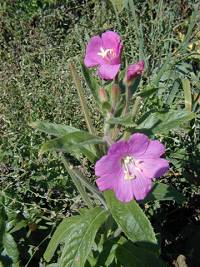 Botanically there was also not a great deal to see, as most of the plants had run to seed, although in a number of places where they had been cut or grazed there was secondary growth and a second flowering, often on plants which were much shorter than one expects to see them, for instance Great Willowherb (Epilobium hirsutum) flowering profusely on a plant no more than a foot tall (left).
Botanically there was also not a great deal to see, as most of the plants had run to seed, although in a number of places where they had been cut or grazed there was secondary growth and a second flowering, often on plants which were much shorter than one expects to see them, for instance Great Willowherb (Epilobium hirsutum) flowering profusely on a plant no more than a foot tall (left).
There was a heavy crop of wild berries, especially haws, but also elderberries, brambles and rose-hips; these will all be very welcome food for the birds, notably the migrant thrushes (fieldfares and redwings) when they arrive from Scandinavia shortly. The river bank supported a wide variety of willows, both trees and large bushes, which I am afraid I could not identify; some of them had large, shiny leaves that suggested hybridisation with bay willow, others had very thin, linear, delicate, rather greyish leaves. There are patches of reeds, and other tall grasses, including Phalaris arundinacea and Tall Fescue (Festuca arundinacea) – this was up to 8' tall in places, whatever the books may say about “3-5 feet”.
There were in fact some interesting plants when we looked more closely, starting with a pale pink variant
of hedge bindweed (Calystegia sepium) growing in just one patch near the car park on the river
bank. 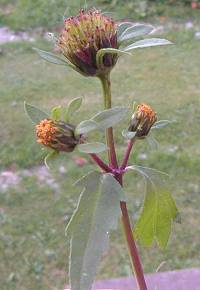 The normal white form was abundant all along the river, and it was good to see this native bindweed
rather than the introduced species C. sylvatica that is all too common in Ryedale hedges.
The normal white form was abundant all along the river, and it was good to see this native bindweed
rather than the introduced species C. sylvatica that is all too common in Ryedale hedges.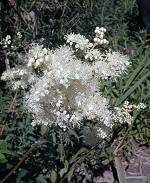 Rather less welcome was the presence of the invasive Himalayan Balsam. We were also pleased to find
sneezewort (Achillea ptarmica) growing profusely along the path sides (and also in a more unusual
short form in some of the adjacent fields – I think these fields had been cut for hay and the plants
were producing a second flowering as there were also short forms of meadowsweet (Filipendula ulmaria,
left) and greater burnet (Sanguisorba officinalis) in bloom, both much later than their normal
season. The highlight for me was finding trifid bur marigold (Bidens tripartita) – the name
perhaps rather more than the plant itself! There were several specimens growing along the edges of the
boardwalk near the hide at the southern edge of the reserve; most of them were over, but I did manage
to find one individual still in flower (right). Although this plant is not rare in the right
habitat it is not one I am familiar with as it does not grow in Ryedale as far as I know. Another unfamiliar
plant was the Water Chickweed (Myosoton aquaticum), which looked much like ordinary chickweed
though a little bigger, but on close examination the differences became apparent: hairs all around the
stem rather than in a single line, and 5 styles instead of 3.
Rather less welcome was the presence of the invasive Himalayan Balsam. We were also pleased to find
sneezewort (Achillea ptarmica) growing profusely along the path sides (and also in a more unusual
short form in some of the adjacent fields – I think these fields had been cut for hay and the plants
were producing a second flowering as there were also short forms of meadowsweet (Filipendula ulmaria,
left) and greater burnet (Sanguisorba officinalis) in bloom, both much later than their normal
season. The highlight for me was finding trifid bur marigold (Bidens tripartita) – the name
perhaps rather more than the plant itself! There were several specimens growing along the edges of the
boardwalk near the hide at the southern edge of the reserve; most of them were over, but I did manage
to find one individual still in flower (right). Although this plant is not rare in the right
habitat it is not one I am familiar with as it does not grow in Ryedale as far as I know. Another unfamiliar
plant was the Water Chickweed (Myosoton aquaticum), which looked much like ordinary chickweed
though a little bigger, but on close examination the differences became apparent: hairs all around the
stem rather than in a single line, and 5 styles instead of 3.
The “lake” overlooked by the southern hide was completely dry (Jim says this is the only time he has ever seen it like this in over 20 years – see below), with the bed looking like something out of the desert with large cracks in bare mud. There were a couple of disconsolate coot walking on it, but not many other birds apart from a few late swallows and house martins. There were however some splendid dragonflies visible from the hide. They had blue-striped bodies and were almost certainly either common or southern hawkers. We also saw brown hawkers with their attractive coppery wings hunting along the taller vegetation of the river bank. Other insects seen included red admiral and comma butterflies.
All in all an enjoyable day out even if we did not see many exciting birds or flowers. Many thanks to Jim for leading it and identifying all the birds for us (and providing the list), and to Nan Sykes for her expertise on the plants. Now we must look forward to next year, as this was our final field trip of the year apart from the Fungus Foray in October.
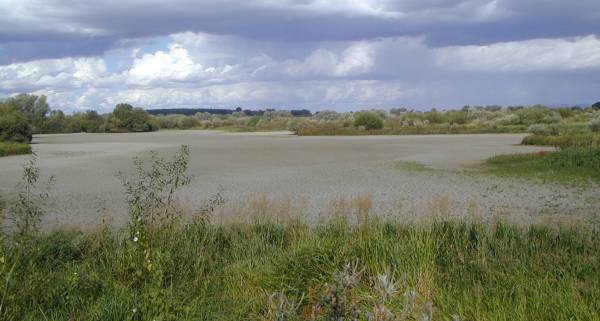
Bird List
Thanks to Jim Pewtress for this (birds seen or heard in order of appearance):
Swallow, Robin, Barn Owl, Blue Tit, Willow Warbler,
Goldfinch, Great Tit, Mute Swan, Woodpigeon, House Martin, Kestrel, Great
Spotted Woodpecker, Bullfinch, Meadow Pipit, Grey Heron, Coot, Chiffchaff,
Blackcap and Reed Bunting.
The last three were seen on the walk back to my
car.
Butterflies
Comma, Red Admiral, Small White and Small Tortoiseshell. (Ed: Also a brown one with cream markings that might have been a speckled wood and a small coppery-orange one that I could not identify.)
| Gill Smith 10th September 2003 | Back to the Index page |
© Ryedale Natural History Society 2003, photos © Adrian Smith 2003
Page last modified 12th September 2003